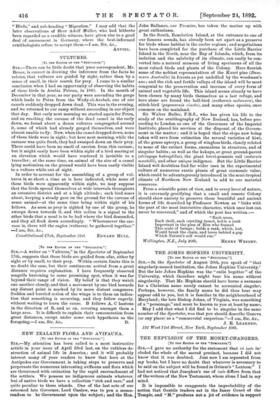NEW ZEALAND FLORA AND AVIFAUNA.
[TO THE EDITOR OF THE " SPECTATOR.")
SIR,—My attention has been called to a most instructive article in your issue of April 23rd last, on the ruthless de- struction of animal life in America ; and it will probably interest many of your readers to know that here at the Antipodes our Government is taking steps to preserve and perpetuate the numerous interesting avifauna and flora which are threatened with extinction by the rapid encroachment of the settlers. We possess no indigenous animals whatever, but of native birds we have a collection "rich and rare," and quite peculiar to these islands. One of the last acts of our esteemed late Governor, Lord Onslow, was to pen a memo- randum to he Government upon the subject; and the Hon.
John Ballance, our Premier, has taken the matter up with great enthusiasm.
In the South, Resolution Island, at the entrance to one of our famous sounds, has already been set apart as a preserve for birds whose habitat is the cooler regions; and negotiations have been completed for the purchase of the Little Barrier Island in the North, near the Bay of Islands, which, from its isolation and the salubrity of its climate, can easily be con- verted into a natural museum of living specimens of all the
most valued birds and plants of the Colony. Here flourish some of the noblest representatives of the Kauri pine (Dam- mara Australis) in forests as yet undefiled by the woodman's
axe; and the rich and fertile valleys of the island will be most congenial to the preservation and increase of every form of animal and vegetable life. This island seems already to have been chosen by many birds themselves as a last refuge, and here alone are found the bell-bird (anthornis melanura), the stitch-bird (pogonornis cincta), and many other species, once common on the mainland.
Sir Walter Buller, F.R.S., who has given his life to the study of the ornithography of New Zealand, has, before pro- ceeding to London as one of the Governors of the Imperial Institute, placed his services at the disposal of the Govern- ment in the matter ; and it is hoped that the steps now being taken will save from extinction the several varieties of kiwi, of the genus apteryx, a group of wingless birds, closely related to some of the extinct forms, anomalous in structure, and of singular habits ; as well as the kakapo, or great ground-parrot (stringops habroptilus), the giant brevi-pennate rail (notornis mantelli), and other unique indigenes. But the Little Barrier Island will doubtless find far wider uses in the experimental culture of numerous exotic plants of great economic valve, which could be advantageously introduced in the semi-tropical climate of Northern New Zealand to add to our material resources.
From a scientific point of view, and to every lover of nature, it is extremely gratifying that a small and remote Colony should show anxiety to preserve those beautiful and ancient forms of life described by Professor Newton as " links with the past of the most instructive character, which once lost can never be recovered," and of which the poet has written :-
"Each moss,
Each shell, each crawling insect, holds a rank Important in the plan of Him who framed This scale of beings ; holds a rank, which, lost, Would break the chain, and leave behind a gap Which Nature's self would rue."


































 Previous page
Previous page